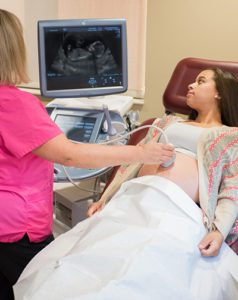If you’ve been pregnant, you’ve heard the word: preeclampsia. It’s an intimidating word, one that we know is associated with a condition that we DON’T want to have. But do we really know what preeclampsia actually is and what problems it can cause in a pregnancy?
Our partner, Miami Valley Hospital’s Maternal-Fetal Medicine Specialist Dr. Jiri Sonek, walks us through the basics of preeclampsia, what symptoms it presents, what harm it can cause and what the treatments are.
What is preeclampsia?
Preeclampsia is a disease that is specific to pregnancy, and in fact, is specific to human pregnancies. It generally develops after 20 weeks gestation and is a problem that can affect any pregnant woman. You might know it by an older term – toxemia. The two main symptoms are high blood pressure and protein in the urine. It’s a disease with a wide range of symptoms and presentations.
Preeclampsia can affect both the mother and the baby adversely. In the mother, preeclampsia can affect many organ systems, including the liver and the brain, especially if it occurs prior to about 34 weeks gestation and if it is severe. You can develop seizures and if those occur, the disease has gone from preeclampsia to eclampsia. Since preeclampsia is thought to be due to a problem with the placenta, it can also restrict fetal nutrition and growth, which could lead to both short and long term problems with the baby. In other words, the fetus can be very small. According to Dr. Sonek, severe preeclampsia can result in early delivery, so the baby could have all of the problems that are associated with prematurity.
Why does someone develop the disease? Is there something I do to cause it?
OK, Mama, let’s relax. Dr. Sonek tells us there is nothing we do as moms to cause it and there really isn’t anything we can do to reduce our risk of developing it. (DMB Mom Perspective: Hallelujah! Something that is not in our control.) He stresses, however, that we all need to be very watchful when it comes to our prenatal care. Even though preeclampsia has been recognized as a disease in pregnancy for centuries, we still do not know exactly what causes it. However, we do know that there are some maternal factors that increase the risk. These include diseases such as hypertension or kidney problems. We also know that it is more common in African American women and in women who are overweight. It is also common in pregnancy with multiples and in women who are having their first baby.
Is there a screening for preeclampsia?
Yes! An effective screening is available to detect a mother’s risk for developing preeclampsia. According to Dr. Sonek, “There is actually a very good screen for the condition that can be done early in pregnancy. This screening is done between 11 and 14 weeks gestation, before you would show any symptoms of preeclampsia. It includes an ultrasound evaluation of the maternal arteries and certain chemical markers that are measured in the maternal blood.” (DMB Mom Tip: Most insurance companies cover preeclampsia screening as part of the complete first trimester screening. Be sure to check with your provider!)
Over the years, doctors have explored different methods of preventing preeclampsia. Various supplements have been tested, from calcium to fish oil, but found to have no effect. The only medication that has been proven to be effective in reducing the risk of preeclampsia involves administration of low dose aspirin. Dr. Sonek stresses that we know this aspirin treatment works only if we start it early in pregnancy, that is, prior to 16 weeks gestation. So, it’s not only the best screen available in the first trimester, but it is critical to be done early in pregnancy.
Is Maternal-Fetal Medicine at Miami Valley Hospital the first in Dayton to offer this preeclampsia test?
Yes, Miami Valley Hospital is the first in Dayton to offer preeclampsia screening. Dr. Sonek tells us what doctors at Miami Valley Hospital have learned about screening for and treating preeclampsia, “We recently completed a study where we evaluated the performance of the first trimester screen, and we actually did find that the vast majority of women who do develop severe early preeclampsia can be detected by the early screen. And, therefore, we can actually effectively reduce the risk for those mothers.”
Preeclampsia screening requires a referral from your doctor, an ultrasound exam, a blood test and a conversation with a nurse. After your data is collected, it will be evaluated by a laboratory that combines all of these factors and gives your doctors a specific risk for you individually.
What are the treatment options for preeclampsia?
The only cure is delivery. That does not mean that delivery is always necessary right away. For example, if the disease is mild and the fetus is doing well, continuing the pregnancy is safe. However, if the disease is severe and especially if the fetus is having problems due to poor placental function, delivery may be necessary even if it is very early in the pregnancy. However, there are medications that can be used to reduce the risk for the mother. These medications include magnesium sulfate to reduce the risk of seizures, as well as blood pressure medicine to bring the pressure down to a safe level.
Does preeclampsia guarantee that I will need to be on bedrest? Does it necessitate a Cesarean section or early delivery?
Not necessarily. Dr. Sonek says this really depends on the specific situation. Bedrest often is an important part of the treatment since your blood pressure increases with activity. Because of the various complications that can occur, your chances of having a C-section are increased, but it is not always necessary. Preeclampsia itself is not an indication for a C-section.
What happens after delivery? What should I watch?
Even though delivery is the only treatment for preeclampsia, it does not go away immediately after delivery. Treatment often is needed for at least a few days after delivery.
In fact, we talked to two local moms, Kate and Zandria, whose preeclampsia problems were more severe AFTER they gave birth than they were during the pregnancy. We know how wonderful it is to finally meet that beautiful baby, but take care of yourself, too! Make sure you follow up with your own medical care as well as your baby’s.
The main thing that your doctors need to do is make sure that your blood pressure returns to normal and that you’re not having any kidney problems.
What resources are available at Miami Valley Hospital?
Especially if you are diagnosed early, you have a higher likelihood of delivering early. Miami Valley Hospital is a tertiary care center, meaning they have all the resources both mom and baby could need, making it the ideal place to deliver.















